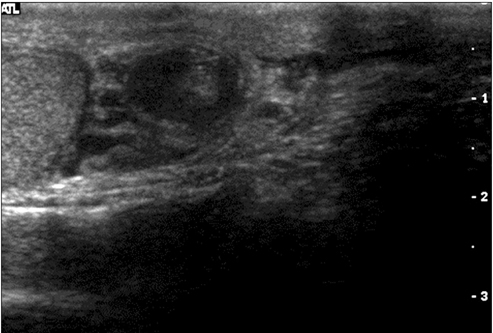Korean J Urol.
2013 Apr;54(4):274-276.
Malacoplakia of the Epididymis
- Affiliations
-
- 1Department of Urology, Dongguk University College of Medicine, Gyeongju, Korea. honda400@dreamwiz.com
- 2Department of Radiology, Dongguk University College of Medicine, Gyeongju, Korea.
Abstract
- Malacoplakia is a chronic inflammatory disease. The disease mainly affects the urinary bladder, although involvement of extravesical sites is increasingly being documented. Most frequently involved is the urinary tract, particularly the urinary bladder, although the testis, epididymis, lungs, bone, colon, prostate, female genital organs, and retroperitoneum can also be involved. Here we report the case of a 61-year-old man with a scrotal mass with histology that was specific for malacoplakia of the epididymis. The histologic workup demonstrated extensive involvement of the epididymis by diffuse infiltrates of large histiocytes with eosinophilic granular cytoplasm and numerous Michaelis-Gutmann bodies, which were diagnostic of malakoplakia. This is the first case of epididymal malacoplakia in our country and the first case of epididymal malacoplakia without concurrent involvement of the testis. There have been few reports of this condition worldwide.
Keyword
MeSH Terms
Figure
Reference
-
1. Park KW, Seo IY, Rim JS. Vesical malacoplakia misdiagnosed as urachal cancer. Korean J Urol. 2002. 43:177–179.2. Yousef GM, Naghibi B, Hamodat MM. Malakoplakia outside the urinary tract. Arch Pathol Lab Med. 2007. 131:297–300.3. McClure J. Malakoplakia. J Pathol. 1983. 140:275–330.4. Green WO Jr. Malacoplakia of the epididymis (without testicular involvement): the first reported case. Arch Pathol. 1968. 86:438–441.5. Long JP Jr, Althausen AF. Malacoplakia: a 25-year experience with a review of the literature. J Urol. 1989. 141:1328–1331.6. Sulman A, Goldman H. Malacoplakia presenting as a large bladder mass. Urology. 2002. 60:163.7. Abdou NI, NaPombejara C, Sagawa A, Ragland C, Stechschulte DJ, Nilsson U, et al. Malakoplakia: evidence for monocyte lysosomal abnormality correctable by cholinergic agonist in vitro and in vivo. N Engl J Med. 1977. 297:1413–1419.8. Stanton MJ, Lynch JH, Maxted WC, Chun BK. Malacoplakia of the bladder: a case report of resolution with bethanechol, trimethoprim-sulfamethoxazole and ascorbic acid. J Urol. 1983. 130:1174–1175.9. van Furth R, van't Wout JW, Wertheimer PA, Zwartendijk J. Ciprofloxacin for treatment of malakoplakia. Lancet. 1992. 339:148–149.



